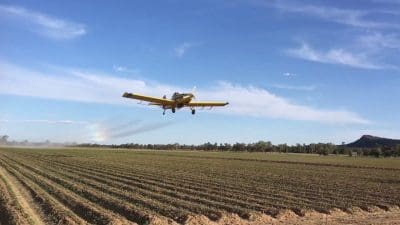RECENT rain in northern NSW has pushed the threat of off-target spray drift for the new cotton season to very high levels, according to Cotton Australia.
 Cotton Australia’s regional manager for northern NSW, Paul Sloman, said rainfall in recent weeks made the risk of spray drift particularly acute.
Cotton Australia’s regional manager for northern NSW, Paul Sloman, said rainfall in recent weeks made the risk of spray drift particularly acute.
He said all farmers, regardless of their crop, could cooperate to overcome the anticipated challenges.
“It is imperative that we all work together as cropping industries, and individually with our neighbours, to combat the threat of off-target spray drift,” Mr Sloman said.
“Most will remember the 2015-16 season, in which 20 per cent of the national cotton crop was affected by spray drift and more than $20 million in damage was caused. It was the worst season for spray drift in living memory, and its impacts are still felt today.”
Cotton Australia urges all farmers, no matter what crop they are growing, to access tools to protect their crops from Phenoxy 2,4-D spray drift, and prevent damage to neighbouring farms.
The vast majority of Australian cotton growers map their fields using online tools such as CottonMap to ensure all farmers in their area can check the location of nearby cotton farms and avoid unacceptable spray drift damage.
“Each season, we ask people to be mindful of weather conditions and to check CottonMap to identify nearby cotton farms before applying weed control, particularly 2,4-D. It is important that we all respect our neighbours and their ability to earn a decent income from their operation,” Mr Sloman said.
“We also remind cotton growers, farm managers, consultants, agronomists and contractors to input their cotton fields into CottonMap to help protect their crop.”
CottonMap is a collaboration between Cotton Australia, Nufarm Australia Limited, the Cotton Research and Development Corporation (CRDC) and the Grains Research and Development Corporation (GRDC).
Mr Sloman said farmers should use the following checklist when preparing to use herbicides, particularly Phenoxy 2,4-D products:
- Read and follow label instructions – it is a legal requirement
- Monitor weather conditions before, during and after spray application
- Use a nozzle that produces coarse or larger droplets
- Check www.CottonMap.com.au for cotton fields that could be potentially impacted by your 2,4-D spray
- Notify your neighbours – even during reasonable conditions for spraying, some spray droplets could travel up to 20km or more if the spray equipment is not used correctly, and more than 70km in some instances of unfavourable conditions, such as during surface temperature inversions
- Minimise boom height when spraying
- Ensure spray contractors are fully trained and accredited
When using insecticides, farmers are also encouraged to check the BeeConnected website – www.BeeConnected.org.au – made available by CropLife Australia to connect with registered beekeepers, enabling two-way communication on the location of hives and crop protection product activities.
Growers and spray contractors can also access a Summer Weed Control Best Practice Guide and a video explaining the risk of temperature inversions from the Cotton Australia website: www.cottonaustralia.com.au
More information on spray drift is available at the following sites:
- CottonMap website: www.cottonmap.com.au
- Spraywise Decisions website: www.spraywisedecisions.com.au
- Grains Research and Development Corporation website: www.grdc.com.au
Broadacre spray drift risk
Off-target spray-drift also poses a significant risk in areas where broadacre cropping farms adjoin horticultural areas, such as in the Mallee where grapevines are at the delicate stage of fruit development.
Agriculture Victoria Biosecurity Area Manager for the Northern Region Ben Perry said there were serious risks associated with inversion drift as spray droplets trapped within an inversion layer tended to remain suspended until the relatively slow-moving air breaks up and releases the trapped droplets.
“One of the biggest risks to horticulture comes from ‘inversion drift’, where damage from spray drift can occur many kilometres from the area being sprayed,” he said.
“Spray droplets trapped in an inversion layer can travel significant distances, so grain growers need to be mindful of not just their immediate neighbours, but those further afield too.
“And with grapevines at this time of year being particularly sensitive to Group 1 herbicides, such as 2,4-D and MCPA, it’s really important that chemical users spray to the weather conditions of the day.
“Drift can injure foliage and fruit, reduce yield, fruit quality and in severe cases result in the eventual death of grapevines.
“There are also serious risks associated with unacceptable chemical residues in fruit produced on affected vines, which can affect the domestic and international wine trade.”
With summer weed spraying starting and continuing through to mid-autumn, now is a good time for farmers to check their spraying methods and regimes;
- Does the intended chemical use follow label directions?
- Are there Agricultural Chemical Control Area (ACCA) restrictions currently in place?
- What are the current weather conditions? (Such as wind speed and direction, likelihood of a temperature inversion, etc.)
- Is the spray equipment suitable for the chemical being sprayed? (Such as appropriate nozzle types and operating pressure)
- Is spraying taking place at the appropriate time of day?
- Are there crops (grapevines or any other crop) in the immediate vicinity which are sensitive to the intended chemical?
- Are adequate records being kept?
Growers who suspect they may have been affected by spray drift are encouraged to contact the Agriculture Victoria Customer Service Centre on 136 186 and ask to speak to their nearest Chemical Standards Officer.
For more information on inversion layers, spraying tips or reporting spray drift visit http://agriculture.vic.gov.au/agriculture/farm-management/chemical-use.
Sources: Cotton Australia, Agriculture Victoria

The spray drift issue is universal. Cotton growers are impacting surrounding farmers and ecosystems almost daily. How come we only hear about what others may be doing to cotton growers?